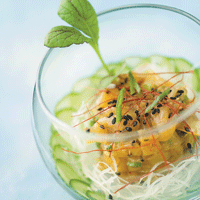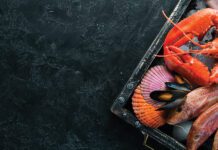An estimated 90 per cent of large, predatory fish have already disappeared from the world’s oceans, and a 2006 scientific study published in the journal Science predicts a worldwide fisheries collapse by 2048. Patently, sustainability has ceased to be an option, and Canadians have recognized this for some time. A 2011 survey by the World Wildlife Fund found that 91 per cent of Canadians feel it’s important that fish and other seafood sold in Canada come from sustainable sources.
Sustainable seafood can be defined as species that are caught or farmed in a way that ensures the long-term health and stability of that species as well as the greater marine ecosystem. With that in mind, fish farming or aquaculture may prove critical to providing enough seafood to feed the planet’s growing demand and take the pressure off wild stocks. According to Ocean Wise, one-third of the world’s seafood production comes from aquaculture. But, while some such operations are moving to methods that don’t endanger other species or the environment, others continue to cause problems.
In the U.S. and Canada, species such as Arctic char, whiteleg shrimp, mussels, scallops and even sturgeon are being sustainably farmed in eco-friendly, closed systems. And black tiger prawns are back on the menu, courtesy of approved operations restoring mangroves in countries such as Vietnam. However, says Ocean Wise, farmed shrimp coming from many other Asian countries and from South America, and fish such as salmon farmed in open pens, remain verboten.
Wild-caught fish became the mantra for a time, but it isn’t a guarantee the product is Ocean-Wise worthy. The viability of the species being fished and the method of fishing are real concerns — is the environment being damaged (as with bottom trawling, for example) or are other species that are caught accidentally (in the bycatch) being destroyed?
Navigating the waters of sustainable seafood can be stormy, but organizations such as Ocean Wise, the Marine Stewardship Council, Sea Choice and the David Suzuki Foundation offer guidance. And, many suppliers and distributors now indicate which products are approved. Nonetheless, the biggest challenge for most chefs is consistent supply.
“I buy from fishermen and local suppliers, but they can’t often give me a firm commitment as to what will be available,” says Steven Galvin, chef at Elements on Hollis in Halifax, who tailors his menu seasonally. “It makes it difficult to plan the menu.”
Michael Steh, chef at The Chase in Toronto agrees. “We recently printed 500 menu cards for the Oyster Bar; then three coastal fisheries shut down due to red tide, and we couldn’t get the oysters,” he says ruefully. “We can’t control what the ocean does. It’s unpredictable. Our challenge is to educate our guests so they understand.”
Making customers aware of the issues is part of the struggle for chefs. “They’re very conservative here in Halifax. They expect the traditional fish — haddock, halibut, salmon — on the menu,” says Galvin, who introduced line-caught swordfish carpaccio recently. “Customers who tried it made comments like, ‘that was actually really good.’ It was pretty funny; did they expect it wouldn’t be?”
Swordfish is on David Suzuki’s Top 10 list of sustainable seafood. Indeed, despite the devastation of many species, the good news is that there is still plenty of some fish in the sea.
Conservationists are encouraging chefs to explore those species that are still abundant, if they are sustainably caught. These include fish such as sardines, ling cod, sablefish and even albacore (but not bluefin) tuna as well as more esoteric varieties such as sea urchin (see “Seafood Spotlight,” p. 20), sea snails, geoduck (pronounced gooey duck) and sea cucumber. And, many chefs are responding to the challenge.
The lunch menu at Laloux in Montreal features whelks — also known as sea snails — with shrimp, peaches, miso mayonnaise and sea asparagus ($7). “It’s the chef’s responsibility to educate people,” says chef, Jonathan Lapierre-Réhayem, who uses Ocean Wise-approved seafood whenever possible. “I tell my customers this is important for the planet and most agree.”
Lapierre-Réhayem introduced sea urchin a couple of years ago. An appetizer of Gaspesian sea-urchin mousse comes with Nordic shrimps, strawberry and cucumber ($16). “It took me a while to figure out a really good recipe,” he laughs. “At first customers were unsure, but there are some adventurous people, and it’s really a beautiful product.”
While Kyle Groves, chef at Catch & The Oyster Bar in Calgary, doesn’t like the flavour of sea urchin himself, he has served it. And geoduck makes an occasional appearance on the menu. “We’ve had success with it, and I like it myself. But we don’t serve it as often as I would like, because it is so expensive,” he laments. “I have to serve a smaller portion than I would like.”
One chef is on a mission to grow the popularity of these more obscure marine offerings. Chef Frank Pabst, of Blue Water Café and Raw Bar in Vancouver, has made an annual event of introducing his customers to new seafood delights. For the past 10 years, every February is Unsung Heroes month. A separate menu of a dozen different dishes features abundant species such as sea urchin, sea cucumber, sea snails, geoduck and even sardines with 10 per cent of the proceeds benefiting Ocean Wise. “I want to expand people’s horizons and promote some of these less well-known species,” Pabst explains. “People are always surprised at how much they enjoy it.” And, he adds, Unsung Heroes month is fun for the chefs at Blue Water. “It gives us a chance to play around with different flavours and stretch ourselves and our customers.”
Encouraging customers to stretch their palates is part of the chef’s role, says Lorna Murdoch, chef at Fusion Grill in Winnipeg. You won’t find the more usual salmon or cod on her menu. Instead, there’s pan-roasted Northern Pike from Lake Kisseynew with miso basil pesto crust, piccolo frito, pickled-ginger potato salad and sesame-seed vinaigrette ($30.95). “The customers are usually pleased, because they expect it to be full of bones,” she says. “But this pike is a beautiful, sustainable fish, which comes from a local coldwater lake. It’s so good we’re constantly being asked where we get our fish.”
In fact, across the country, chefs are turning to local lakes or rivers for their fish, eschewing the better known, but less sustainable, varieties. At Le Chien Noir in Kingston, Ont., local pickerel comes with jumbo confit frites, warm fennel, lemon preserve and Foreman Farms cherry tomato salad and sauce gribiche ($26), and chili-marinated local perch is served in tacos with pickled
red onions, lime cabbage slaw and cumin crema ($16).
In Vancouver, Central Bistro features grilled Copper River salmon with shimeji mushroom cream sauce, garlic and herb confit fennel, locally grown asparagus and lemon-scented Beluga lentils ($22). Fraser Macfarlane, chef at Quatrefoil in Dundas, Ont., serves Georgian Bay whitefish with honey mushroom, edamame, braised daikon, baby bok choy, ginger and soy emulsion ($20). And, chef Brad Long sources the fish in Cafe Belong’s Port Dover fish stew ($19) from Lake Erie, a short distance from his Toronto restaurant.
In keeping with the sustainable theme, a nose-to-snout philosophy can come into play with fish as well. Thus, it’s not unusual to find fish cheeks or tongues on menus across the country. At Aqua in St. John’s, N.L., chef Mark McCrowe coats cod tongues and cheeks with cornmeal and serves them crisp with salsa, sumac yogurt and smoked chili oil ($14). Pickerel cheeks are panko-crusted and served with crispy yam frites and pickled asparagus tartar sauce ($14.95) at Fusion Grill in Winnipeg. At Joe Fortes in Vancouver, local halibut cheeks are served with tomato, leeks, herbs, butter and Yukon Gold potatoes ($33.95). Even the bones can be used. When Elements’ Galvin was given some locally caught monkfish, he used the fillets, then chopped and roasted the head and spine bones with a mirepoix and tomato paste, using it to make a dark stock. This became the base for monkfish cheek bourguignon.
Ultimately, serving sustainable seafood seems to be an exercise in building networks. Small suppliers who specialize in local, smaller scale harvested or even unique species can be found across the country. And, chefs are turning to them to add interest to a menu that is being slowly stripped of the traditional, unsustainable favourites. These cost a little more, but Pabst sums it up best: “We can’t keep taking from the sea. We have to work with Mother Nature.”




















